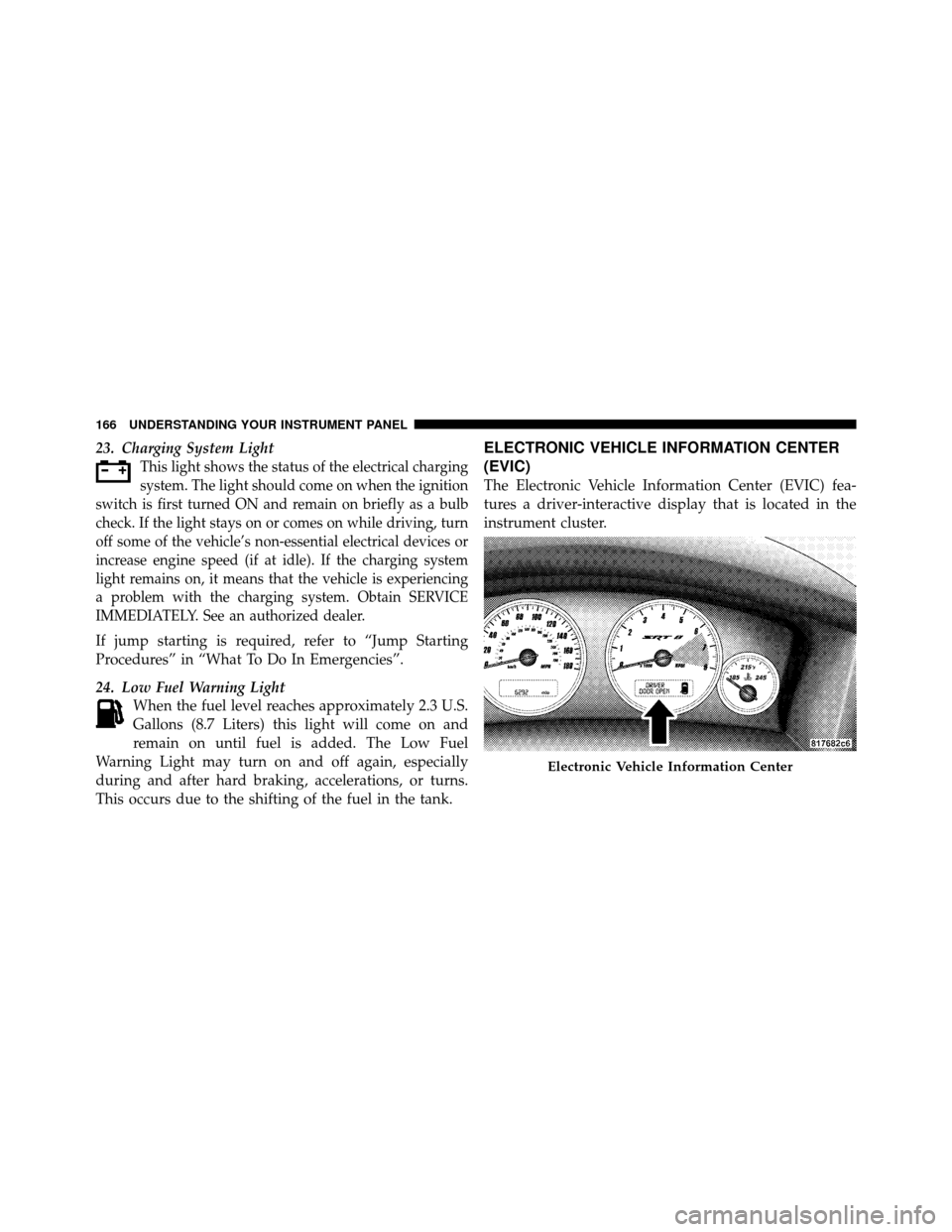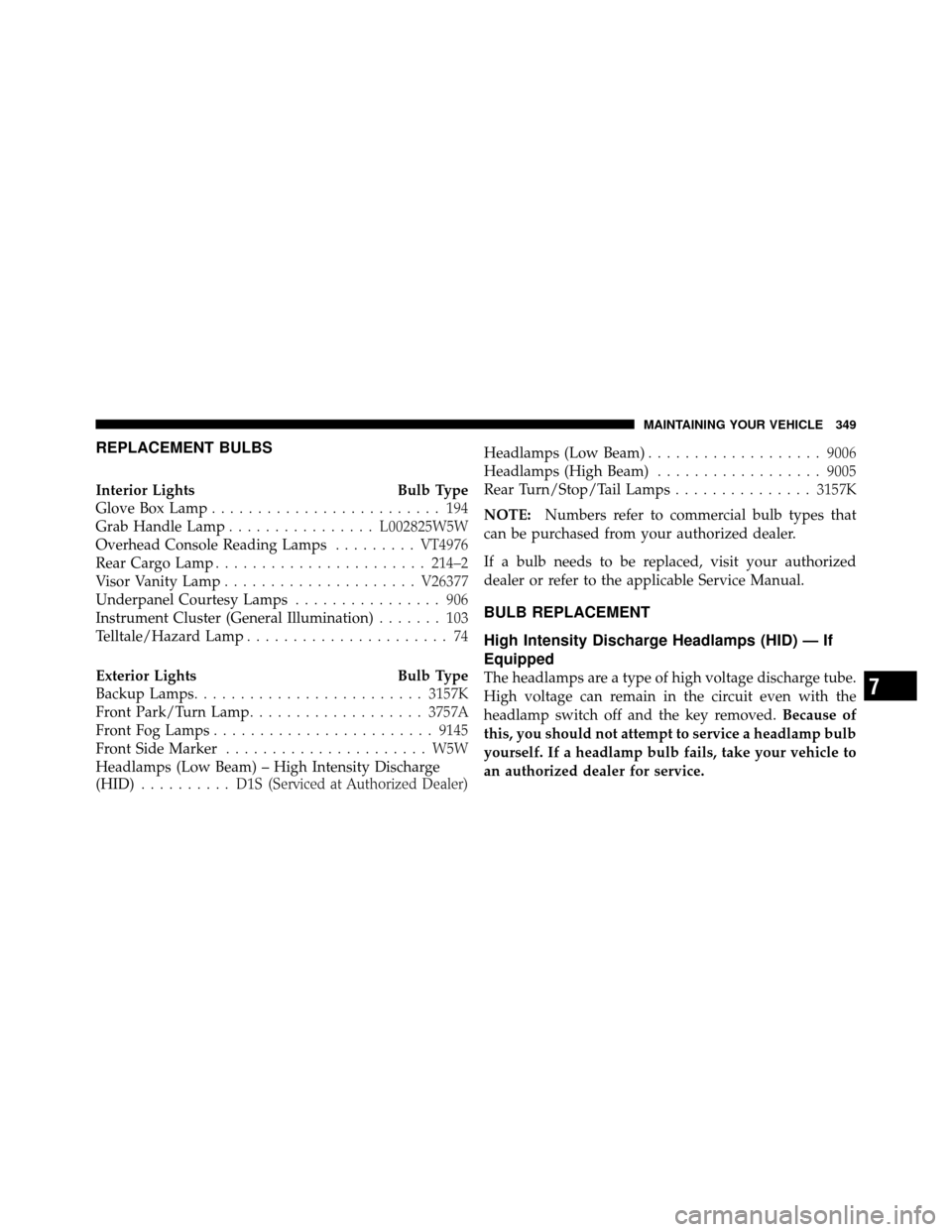Page 167 of 407

23. Charging System Light
This light shows the status of the electrical charging
system. The light should come on when the ignition
switch is first turned ON and remain on briefly as a bulb
check. If the light stays on or comes on while driving, turn
off some of the vehicle’s non-essential electrical devices or
increase engine speed (if at idle). If the charging system
light remains on, it means that the vehicle is experiencing
a problem with the charging system. Obtain SERVICE
IMMEDIATELY. See an authorized dealer.
If jump starting is required, refer to “Jump Starting
Procedures” in “What To Do In Emergencies”.
24. Low Fuel Warning Light When the fuel level reaches approximately 2.3 U.S.
Gallons (8.7 Liters) this light will come on and
remain on until fuel is added. The Low Fuel
Warning Light may turn on and off again, especially
during and after hard braking, accelerations, or turns.
This occurs due to the shifting of the fuel in the tank.
ELECTRONIC VEHICLE INFORMATION CENTER
(EVIC)
The Electronic Vehicle Information Center (EVIC) fea-
tures a driver-interactive display that is located in the
instrument cluster.
Electronic Vehicle Information Center
166 UNDERSTANDING YOUR INSTRUMENT PANEL
Page 313 of 407

▫Brake System ....................... 334
▫ Automatic Transmission ............... 335
▫ Appearance Care And Protection From
Corrosion .......................... 336
� Fuses .............................. 341
▫ Interior Fuses ....................... 341
▫ Underhood Fuses
(Power Distribution Center) ............. 343
▫ Underhood Fuses
(Integrated Power Module) ............. 346
� Vehicle Storage ....................... 348
� Replacement Bulbs .................... 349
� Bulb Replacement ..................... 349 ▫
High Intensity Discharge Headlamps (HID)
— If Equipped ...................... 349
▫ Halogen Headlamps — If Equipped ....... 350
▫ Front Turn Signal .................... 351
▫ Front Fog Lamp ..................... 352
▫ Rear Tail, Stop, Turn Signal, And Backup
Lamps ............................ 352
▫ Center High-Mounted Stop Lamp
(CHMSL) .......................... 354
� Fluid Capacities ...................... 355
� Fluids, Lubricants, And Genuine Parts ....... 356
▫ Engine ............................ 356
▫ Chassis ........................... 357
312 MAINTAINING YOUR VEHICLE
Page 317 of 407

Your vehicle has a simple ignition key-actuated test,
which you can use prior to going to the test station. To
check if your vehicle’s OBD II system is ready, you must
do the following:
1. Turn the ignition switch to the ON position, but do not
crank or start the engine.
2. If you crank or start the engine, you will have to start
this test over.
3. As soon as you turn the ignition switch to the ON
position, you will see the MIL symbol come on as part of
a normal bulb check.
4. Approximately 15 seconds later, one of two things will
happen:a. The MIL will flash for about 10 seconds and then
return to being fully illuminated until you turn OFF the ignition or start the engine. This means that your
vehicle’s OBD II system is
not readyand you should
not proceed to the I/M station.
b. The MIL will not flash at all and will remain fully
illuminated until you turn OFF the ignition or start the
engine. This means that your vehicle’s OBD II system
is ready and you can proceed to the I/M station.
If your OBD II system is not ready,you should see your
authorized dealer or repair facility. If your vehicle was
recently serviced or had a battery failure or replacement,
you may need to do nothing more than drive your
vehicle as you normally would in order for your OBD II
system to update. A recheck with the above test routine
may then indicate that the system is now ready.
Regardless of whether your vehicle’s OBD II system is
ready or not, if the MIL is illuminated during normal
vehicle operation you should have your vehicle serviced
316 MAINTAINING YOUR VEHICLE
Page 350 of 407

REPLACEMENT BULBS
Interior LightsBulb Type
Glove Box Lamp ......................... 194
Grab Handle Lamp ................ L002825W5W
Overhead Console Reading Lamps .........VT4976
Rear Cargo Lamp ....................... 214–2
Visor Vanity Lamp ..................... V26377
Underpanel Courtesy Lamps ................ 906
Instrument Cluster (General Illumination) ....... 103
Telltale/Hazard Lamp ...................... 74
Exterior Lights Bulb Type
Backup Lamps ......................... 3157K
Front Park/Turn Lamp ................... 3757A
Front Fog Lamps ........................ 9145
Front Side Marker ...................... W5W
Headlamps (Low Beam) – High Intensity Discharge
(HID) .......... D1S (Serviced at Authorized Dealer) Headlamps (Low Beam)
................... 9006
Headlamps (High Beam) ..................9005
Rear Turn/Stop/Tail Lamps ...............3157K
NOTE: Numbers refer to commercial bulb types that
can be purchased from your authorized dealer.
If a bulb needs to be replaced, visit your authorized
dealer or refer to the applicable Service Manual.
BULB REPLACEMENT
High Intensity Discharge Headlamps (HID) — If
Equipped
The headlamps are a type of high voltage discharge tube.
High voltage can remain in the circuit even with the
headlamp switch off and the key removed. Because of
this, you should not attempt to service a headlamp bulb
yourself. If a headlamp bulb fails, take your vehicle to
an authorized dealer for service.7
MAINTAINING YOUR VEHICLE 349
Page 351 of 407
WARNING!
A transient high tension occurs at the bulb sockets of
High Intensity Discharge (HID) headlamps when the
headlamp switch is turned ON. It may cause serious
electrical shock or electrocution if not serviced prop-
erly. See your authorized dealer for service.
NOTE: On vehicles equipped with High Intensity Dis-
charge (HID) headlamps, when the headlamps are
turned on, there is a blue hue to the lamps. This dimin-
ishes and becomes more white after approximately
10 seconds, as the system charges.
Halogen Headlamps — If Equipped
1. Open the hood.
2. Turn the low or high beam bulb one–quarter turn
counterclockwise to remove from housing. 3. Disconnect the electrical connector and replace the
bulb.
1 — High Beam Bulb
3 — Turn Signal Bulb
2 — Low Beam Bulb
350 MAINTAINING YOUR VEHICLE
Page 352 of 407
CAUTION!
Do not touch the new bulb with your fingers. Oil
contamination will severely shorten bulb life. If the
bulb comes in contact with any oily surface, clean the
bulb with rubbing alcohol.
Front Turn Signal
1. Open the hood.
2. Turn the turn signal bulb one–quarter turn counter-
clockwise to remove from housing.3. Disconnect the electrical connector and replace the
bulb.
1 — High Beam Bulb3 — Turn Signal Bulb
2 — Low Beam Bulb
7
MAINTAINING YOUR VEHICLE 351
Page 353 of 407
CAUTION!
Do not touch the new bulb with your fingers. Oil
contamination will severely shorten bulb life. If the
bulb comes in contact with any oily surface, clean the
bulb with rubbing alcohol.
Front Fog Lamp
1. Reach behind the front fascia from under the vehicle.
2. Turn the front fog lamp bulb one–quarter turn coun-
terclockwise to remove from housing.
3. Disconnect the electrical connector and replace bulb.
CAUTION!
Do not touch the new bulb with your fingers. Oil
contamination will severely shorten bulb life. If the
bulb comes in contact with any oily surface, clean the
bulb with rubbing alcohol.
Rear Tail, Stop, Turn Signal, And Backup Lamps
1. Raise the liftgate.
2. Remove the two Torx fasteners.
352 MAINTAINING YOUR VEHICLE
Page 354 of 407
3. Squeeze the socket assembly tabs to remove it from the
housing.4. Pull the bulb to remove it from the socket.
5. Replace the bulb, reinstall the socket, and reattach the
lamp assembly.1 — Tail/Stop Lamp Bulb 3 — Back-Up Lamp Bulb
2 — Tail/Turn Signal Bulb
7
MAINTAINING YOUR VEHICLE 353